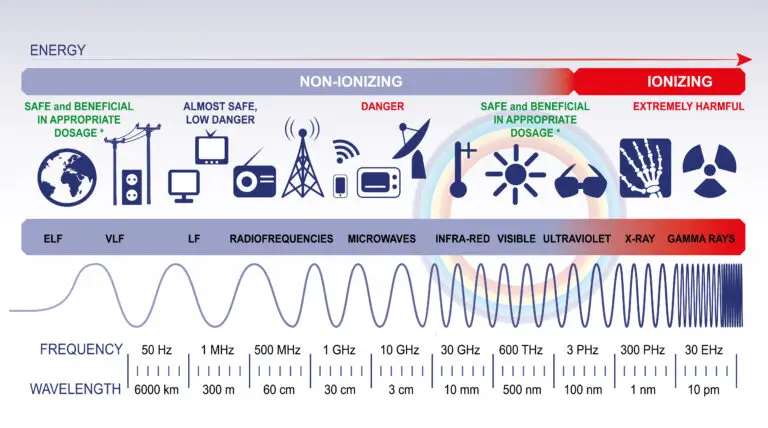Ultraviolet Radiation

Table of Contents
What is Ultraviolet Radiation?
Ultraviolet (UV) radiation is a form of electromagnetic energy situated in the spectrum between visible light and X-rays. Its wavelengths range approximately from 10 to 400 nanometers (nm), making them shorter than visible light, which spans from about 400 to 700 nm, and longer than those of X-rays, which start from below 10 nm.
UV Wavelength Range
UV radiation is divided into several categories based on its wavelength:
- UVA (320-400 nm): These are the longest UV wavelengths and are less energetic but can penetrate deeper into the skin, causing aging and long-term skin damage.
- UVB (280-320 nm): UVB rays have more energy than UVA and are responsible for causing sunburn. They play a key role in the development of skin cancer and contribute to the production of vitamin D in the skin.
- UVC (100-280 nm): These are the shortest UV wavelengths and are extremely harmful but are mostly absorbed by the Earth’s atmosphere and do not reach its surface.
Despite its potential risks to health, such as skin cancer and eye damage, UV radiation also has beneficial applications. It is used for sterilization and disinfection, in the treatment of certain skin conditions, and in the creation of fluorescent effects. Additionally, UV radiation from the sun helps the body produce vitamin D, which is crucial for maintaining healthy bones and immune function.
Natural and Artificial UV Sources
The Sun is the most significant natural ultraviolet (UV) radiation source. It emits a broad spectrum of electromagnetic radiation, including UV, visible light, and infrared. When UV radiation from the sun reaches the Earth’s surface, it affects living organisms and the environment. In humans, exposure to UV radiation can lead to sunburn and tanning as the skin reacts to protect itself from damage. Despite these risks, UV radiation is also crucial for the synthesis of vitamin D in the skin, which is essential for bone health and immune function.
Besides natural sunlight, there are several artificial sources of UV radiation:
UV Lamps and Bulbs: These are commonly used in tanning beds and salons to mimic the effects of sun exposure, providing a tanned appearance. However, like natural sunlight, they can also pose risks such as skin damage and increased risk of skin cancer due to prolonged exposure.
Disinfection and Sterilization: UV lamps are widely used for sterilization and disinfection purposes. They can effectively kill bacteria, viruses, and other pathogens in water, air, and on surfaces, making them invaluable in water treatment facilities, air purification systems, and healthcare settings to maintain hygiene and prevent the spread of infections.
UV Lasers: Employed in various scientific, industrial, and medical applications, UV lasers offer precise and controlled UV radiation. They are used in processes like the cutting and engraving of materials, spectroscopy in research, and certain medical treatments, including dermatological procedures and eye surgery.
UV Index
The UV Index is an international standard measurement of the strength of sunburn-producing ultraviolet (UV) radiation at a particular place and time. Developed to help people understand the potential risk of UV exposure, the UV Index is crucial for promoting sun safety and preventing overexposure to UV radiation, which can lead to skin burns, long-term skin damage, and increased risk of skin cancer.
The index typically ranges from 0 to 11+ in increasing order of potential harm:
- 0 to 2 (Low): Minimal risk to the average person. Basic sun protection, like wearing sunglasses, may be sufficient.
- 3 to 5 (Moderate): Moderate risk of harm from unprotected sun exposure. Wearing sunscreen, protective clothing, and staying in the shade during midday hours are recommended.
- 6 to 7 (High): High risk of harm. Increased protection is necessary; people are advised to cover up, use sunscreen, seek shade, and avoid the sun during midday.
- 8 to 10 (Very High): Very high risk. Extra precautions are needed, such as wearing SPF-rated clothing, applying high-SPF sunscreen, and avoiding outdoor activities during peak sunlight hours.
- 11+ (Extreme): Extreme risk of harm. Full sun protection is essential; midday sun exposure should be avoided completely.
The UV Index varies throughout the day and is influenced by several factors, including the time of year, cloud cover, altitude, and proximity to the equator. Public health organizations and weather services often provide daily UV Index forecasts to help individuals plan their outdoor activities and select the appropriate level of sun protection to reduce the risks associated with UV radiation exposure.
UV Protection and Safety
Minimizing the risks of UV radiation exposure is essential for protecting skin and eye health. Here are some recommended strategies for reducing UV exposure and protecting against its harmful effects:
Limit Outdoor Activities During Peak Sunlight Hours: UV radiation is typically strongest between 10 a.m. and 4 p.m. Limiting outdoor activities during these hours can significantly reduce the risk of overexposure.
Use Broad-Spectrum Sunscreen: Apply a broad-spectrum sunscreen that protects against UVA and UVB rays, with a high Sun Protection Factor (SPF) of at least 30. Reapply every two hours or more frequently if swimming or sweating.
Wear Protective Clothing: Long-sleeved shirts, long pants, and wide-brimmed hats can effectively protect against UV rays. Clothing made from tightly woven fabric offers the best defense. Some clothing is specially designed with UV protection in mind, known as UPF (Ultraviolet Protection Factor) rated clothing.
Wear Sunglasses that Block UV Radiation: Sunglasses that offer 99% to 100% UVA and UVB protection help protect the eyes and the surrounding skin from sun damage. Wrap-around sunglasses offer the best protection by blocking rays from entering from the side.
Avoid Artificial Tanning Devices: Tanning beds and lamps emit UV radiation and can increase the risk of skin damage and skin cancer. Opting for sunless tanning products can provide a safer alternative to achieve a tanned look without UV exposure risks.
Related Links
Energy
Heat
Radiation
Refraction